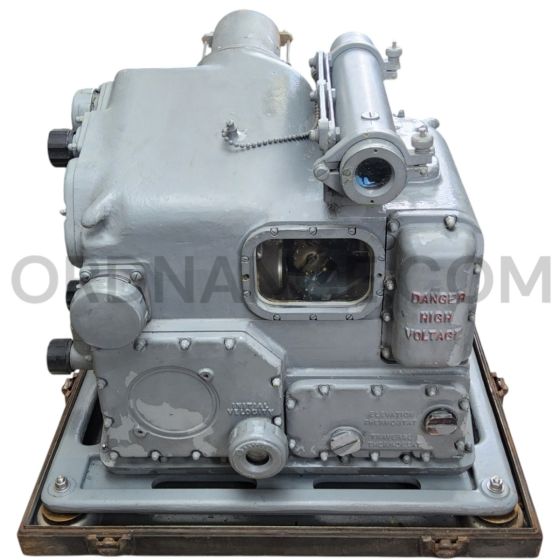The 3"/50 Cal Mark 29 Mod 1 Gun Sight is an exceptional artifact of naval fire control technology from World War II, designed to improve interception capabilities in high-intensity combat scenarios. Developed by the Navy Weapons Agency, this advanced gun sight was an integral component of the U.S. Navy's fire control systems, allowing operators to achieve blind shooting and high-precision targeting of evasive threats within 4,000 yards (3,700 meters).
Historical Significance:
Initially tested in June 1944 and deployed later that year, the Mark 29 Mod 1 Gun Sight was a key component in improving the accuracy of the 3"/50 Caliber Mark 22 Dual-Purpose Gun. Its integration with disturbed-line-of-sight systems and radar capabilities marked a leap forward in naval gunnery. The radar-enabled Mk.29 gun sight allowed operators to engage unseen targets, making it an invaluable tool during critical engagements, including the Battle of Okinawa, one of the fiercest campaigns of the Pacific Theater.
Equipped with advanced radar systems like the S-band Mk.28 and later the X-band Mk.34, the Mk.29 was specifically engineered to counter the challenge of narrow radar beam widths. The addition of a "Notting mechanism," which oscillated the radar antenna up to 20 degrees, improved target acquisition and made it easier to track fast-moving, evasive aircraft and ships. These innovations proved pivotal in bolstering the U.S. Navy's defensive and offensive capabilities.
Features:
- Blind Shooting Capability: Integrated radar display within the sight's field of view enabled engagement of unseen targets.
- Precision Fire Control: Designed to intercept evasive targets within a range of 4,000 yards.
- Historical Usage: First deployed on aircraft carriers in late 1944 and used extensively during the Battle of Okinawa.
- Advanced Engineering: Features a human-operated disturbed-line-of-sight system and innovative radar-driven targeting.
- Condition: Very good condition.
- Display-Ready: Ideal for collectors, historians, or museums showcasing naval warfare advancements.
Own a part of history that demonstrates the relentless pursuit of precision and efficiency in naval combat. Add the 3"/50 Cal Mark 29 Mod 1 Gun Sight to your collection today.
Approx length 24", Approx width 21", Approx height 12", Approx weight 216lbs.
Pictures are stock images of our inventory. Unless otherwise noted, you will not be receiving the exact item shown in the pictures. The pictures are representative of the item's general condition. The item you receive might be slightly better, or worse, condition than was shown in the pictures.
Please visit our page about order lead times here: Order Lead Times

